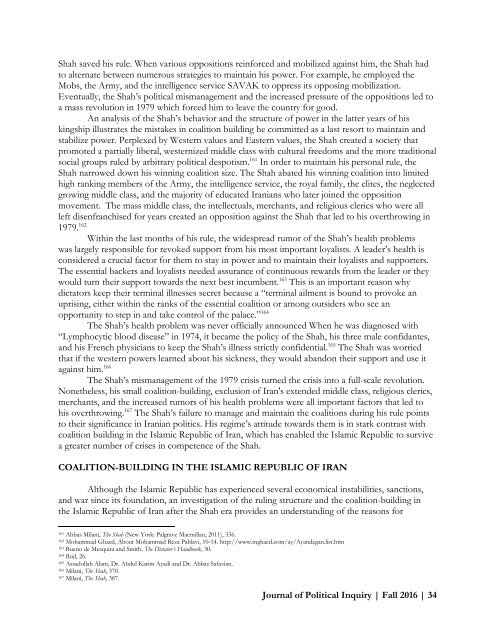Fall2016_Final
You also want an ePaper? Increase the reach of your titles
YUMPU automatically turns print PDFs into web optimized ePapers that Google loves.
Shah saved his rule. When various oppositions reinforced and mobilized against him, the Shah had<br />
to alternate between numerous strategies to maintain his power. For example, he employed the<br />
Mobs, the Army, and the intelligence service SAVAK to oppress its opposing mobilization.<br />
Eventually, the Shah’s political mismanagement and the increased pressure of the oppositions led to<br />
a mass revolution in 1979 which forced him to leave the country for good.<br />
An analysis of the Shah’s behavior and the structure of power in the latter years of his<br />
kingship illustrates the mistakes in coalition building he committed as a last resort to maintain and<br />
stabilize power. Perplexed by Western values and Eastern values, the Shah created a society that<br />
promoted a partially liberal, westernized middle class with cultural freedoms and the more traditional<br />
social groups ruled by arbitrary political despotism. 161 In order to maintain his personal rule, the<br />
Shah narrowed down his winning coalition size. The Shah abated his winning coalition into limited<br />
high ranking members of the Army, the intelligence service, the royal family, the elites, the neglected<br />
growing middle class, and the majority of educated Iranians who later joined the opposition<br />
movement. The mass middle class, the intellectuals, merchants, and religious clerics who were all<br />
left disenfranchised for years created an opposition against the Shah that led to his overthrowing in<br />
1979. 162<br />
Within the last months of his rule, the widespread rumor of the Shah’s health problems<br />
was largely responsible for revoked support from his most important loyalists. A leader’s health is<br />
considered a crucial factor for them to stay in power and to maintain their loyalists and supporters.<br />
The essential backers and loyalists needed assurance of continuous rewards from the leader or they<br />
would turn their support towards the next best incumbent. 163 This is an important reason why<br />
dictators keep their terminal illnesses secret because a “terminal ailment is bound to provoke an<br />
uprising, either within the ranks of the essential coalition or among outsiders who see an<br />
opportunity to step in and take control of the palace.” 164<br />
The Shah’s health problem was never officially announced When he was diagnosed with<br />
“Lymphocytic blood disease” in 1974, it became the policy of the Shah, his three male confidantes,<br />
and his French physicians to keep the Shah’s illness strictly confidential. 165 The Shah was worried<br />
that if the western powers learned about his sickness, they would abandon their support and use it<br />
against him. 166<br />
The Shah’s mismanagement of the 1979 crisis turned the crisis into a full-scale revolution.<br />
Nonetheless, his small coalition-building, exclusion of Iran's extended middle class, religious clerics,<br />
merchants, and the increased rumors of his health problems were all important factors that led to<br />
his overthrowing. 167 The Shah’s failure to manage and maintain the coalitions during his rule points<br />
to their significance in Iranian politics. His regime’s attitude towards them is in stark contrast with<br />
coalition building in the Islamic Republic of Iran, which has enabled the Islamic Republic to survive<br />
a greater number of crises in competence of the Shah.<br />
COALITION-BUILDING IN THE ISLAMIC REPUBLIC OF IRAN<br />
Although the Islamic Republic has experienced several economical instabilities, sanctions,<br />
and war since its foundation, an investigation of the ruling structure and the coalition-building in<br />
the Islamic Republic of Iran after the Shah era provides an understanding of the reasons for<br />
161<br />
Abbas Milani, The Shah (New York: Palgrave Macmillan, 2011), 336.<br />
162<br />
Mohammad Ghaed, About Mohammad Reza Pahlavi, 10-14. http://www.mghaed.com/ay/Ayandegan.list.htm<br />
163<br />
Bueno de Mesquita and Smith, The Dictator’s Handbook, 30.<br />
164<br />
Ibid, 26.<br />
165<br />
Assadollah Alam, Dr. Abdul Karim Ayadi and Dr. Abbas Safavian.<br />
166<br />
Milani, The Shah, 370.<br />
167<br />
Milani, The Shah, 387.<br />
Journal of Political Inquiry | Fall 2016 | 34
















